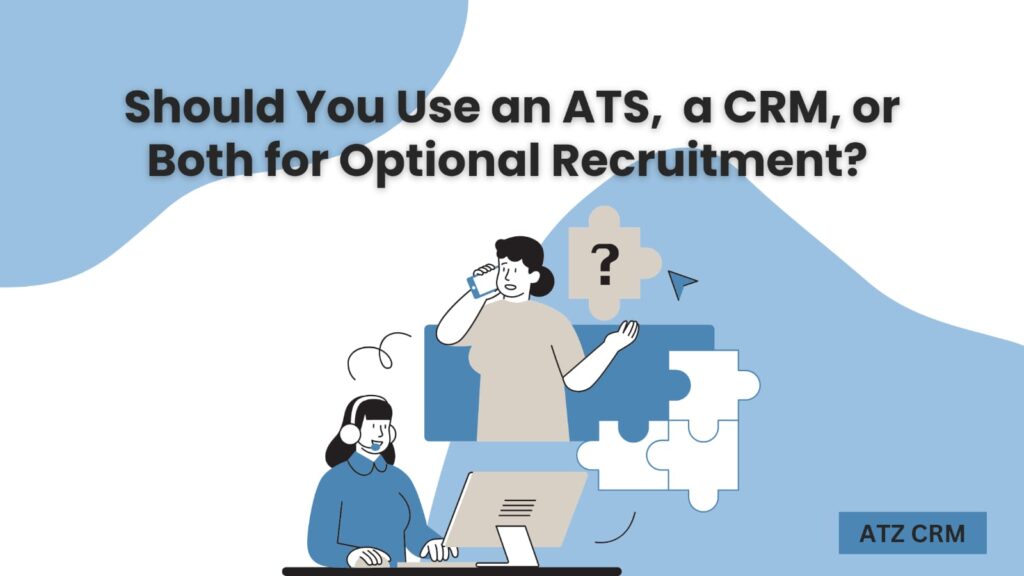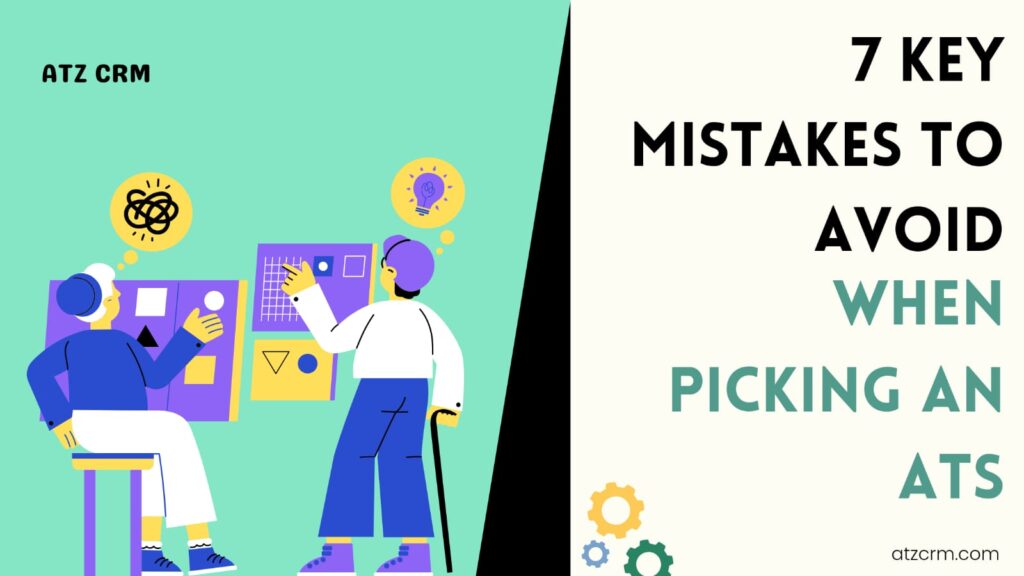Imagine this: you’re in the middle of a major recruitment drive, juggling dozens (or even hundreds) of applicants for various positions. Each applicant brings unique skills, experiences, and expectations, making it challenging to manage everything while also staying responsive, organized, and effective. The pressure is on—do you reach for an ATS to handle the flood of applications, or is a CRM better suited to nurture long-term relationships with passive candidates? Here’s where it gets tricky: understanding the role each tool plays can feel like searching for a needle in a haystack.
You might ask yourself, “Can one tool handle it all?” or “Is it essential to have both?”
As a recruiter or HR professional, you know that each stage of the hiring process has unique demands, from sourcing talent to nurturing relationships and finally onboarding the right fit. Applicant Tracking Systems (ATS) and Candidate Relationship Management (CRM) tools each offer distinct advantages, but the choice can vary based on your hiring goals. This guide will break down how these tools differ, the specific advantages of each, and help you decide the best fit for your company’s unique needs.
Quick Joke: Why did the recruiter break up with their CRM? Because it just wasn’t tracking anymore! 🥁
An Applicant Tracking System (ATS) is software designed primarily for handling, organizing, and filtering job applications. An ATS is the backbone of many hiring teams, automating repetitive tasks, storing resumes, and managing candidate profiles. ATS platforms often have features like resume parsing, automated email responses, and interview scheduling. They streamline the administrative side of hiring, making it possible to manage high volumes of applications while maintaining efficiency and compliance.
Core Functions of an ATS:
- Resume Sorting and Filtering: Automatically scan and sort resumes based on keywords or qualifications.
- Job Posting Automation: Post openings to multiple job boards simultaneously.
- Interview Management: Schedule interviews and communicate with candidates efficiently.
Related Read: Looking to get the most out of your ATS? Check out our blog on 10 Proven Recruitment Strategies for Maximum ATS ROI.
If your goal is efficiency, an ATS is essential. This system is crucial for high-volume recruitment environments where time is limited, and the number of applicants is substantial. Here are key benefits:
- Saves Time and Resources: Automating tasks like resume sorting, email responses, and interview scheduling lets recruiters focus on more strategic work.
- Enhances Compliance: Many ATS platforms include features that support fair hiring practices and regulatory compliance, which is essential in heavily regulated industries.
- Improves Candidate Screening: By organizing candidate information and utilizing filters, an ATS enables recruiters to find qualified candidates faster, aiding in quick and efficient hiring.
For a high-volume hiring environment or organizations with complex compliance needs, an ATS is a game-changer.
Candidate Relationship Management (CRM) software is designed to build, nurture, and manage relationships with potential candidates. Unlike ATS, which focuses on active applicants, CRM tools help recruiters engage passive candidates—those who aren’t actively looking but may be open to future opportunities. A CRM’s core strength lies in candidate outreach, nurturing, and engagement, making it indispensable for organizations focused on long-term talent acquisition.
Core Functions of a CRM:
- Candidate Engagement: Send automated, personalized messages to passive candidates.
- Pipeline Building: Maintain a pool of engaged candidates for future openings.
- Brand Building: Improve candidate experience by staying connected and responsive.
Related Read: If building a strong talent pipeline interests you, check out What is Recruitment Marketing?
If you’re focused on building a talent pipeline, a CRM can be invaluable. Here’s how:
- Nurtures Long-Term Relationships: CRM software allows recruiters to maintain ongoing relationships with passive candidates, keeping them engaged through regular updates and nurturing until they’re ready to apply.
- Improves Candidate Experience: By facilitating personalized communication, a CRM provides a better experience for candidates, which can enhance your employer brand.
- Supports Strategic Hiring: By building a database of potential candidates, companies can proactively reach out when new roles open, reducing time-to-fill and helping to hire better-qualified candidates.
For companies with long-term hiring goals, a CRM is a vital tool to attract and maintain relationships with top talent.
While both ATS and CRM software serve recruitment, they have distinct purposes. Fundamental differences:
- Core Focus: ATS targets job Screening, organizing applications, while CRM targets passive candidate relationships.
- Primary Function: ATS streamlines recruitment operations, whereas CRM builds talent pipelines.
- Time Frame: ATS is short-term and process-focused, while CRM emphasizes long-term relationship building.
- Best For: ATS is best for High-volume hiring, whereas CRM is best for Long-term talent pipeline
While an ATS keeps the wheels turning for your immediate hiring needs, a CRM helps ensure you have a strong, engaged talent pool ready to go for future needs.
Pro Tip: Many companies find success by integrating ATS and CRM tools to enjoy the best of both worlds.
Absolutely! Many companies combine ATS and CRM to gain the best of both worlds. Here’s how:
Integrated Workflows: When an ATS and CRM work together, recruiters can maintain a database of passive candidates and track them from initial contact through application and hiring.
Enhanced Candidate Experience: Using both tools enables more personalized outreach and engagement, creating a seamless experience for candidates.
Improved Talent Pool: With both ATS and CRM, companies can both source and manage candidates effectively, creating a robust talent pipeline for future needs.
Combining an ATS and a CRM maximizes recruiting efficiency while building long-term relationships with candidates.
Using both ATS and CRM maximizes recruitment efficiency while building long-term relationships. Discover how combining ATS and CRM tools can enhance recruitment.
Why would a company invest in an ATS? Here are some key advantages:
- Efficiency in High-Volume Recruiting: An ATS automates time-consuming tasks, enabling recruiters to handle a higher volume of applicants.
- Compliance and Record-Keeping: With built-in tracking and reporting, an ATS helps businesses comply with equal opportunity and labor laws.
- Faster Hiring Process: By automating processes like resume sorting and interview scheduling, an ATS can reduce the time-to-hire metric significantly.
Related Read: Discover 10 Free Powerful ATS for Small Businesses in 2024 for some options if you’re a smaller company on a budget.
CRM offers unique advantages when it comes to candidate relationship management:
- Long-Term Talent Engagement: A CRM keeps candidates engaged even when you’re not actively hiring, which is essential for building a strong talent pool.
- Enhanced Candidate Experience: By providing personalized communication, CRMs help improve candidate satisfaction and strengthen your brand.
- Better Quality Hires: Engaged candidates are often more invested, making them better-quality hires when a position becomes available.
See the importance of CRM in recruitment for a deeper dive.

1. When to Use an ATS
If your company has a high volume of job openings or receives a large number of applications, an ATS will streamline your recruitment process. For example, large organizations, recruitment agencies, and industries with high turnover often benefit most from ATS features like resume filtering, automated job postings, and interview scheduling.
2. When to Use a CRM
A CRM is ideal for industries where the competition for talent is fierce, and the hiring process takes time. In fields like tech or healthcare, where top talent is constantly in demand, nurturing a candidate pool is crucial.
3. When to Use Both
For integrated approaches, many modern recruitment platforms now offer ATS-CRM solutions.Find more insights on combining ATS and CRM for talent acquisition.
Combining ATS and CRM functionalities gives you a robust hiring ecosystem. Many modern recruitment platforms now offer integrated ATS-CRM solutions that allow recruiters to manage immediate needs while building a long-term talent strategy.
Related Read: For insights into ATS-CRM integration, check out How to Streamline the Hiring Process: 10 Proven Ways.
As recruitment technologies evolve, so does the demand for seamless integrations between ATS and CRM tools. The industry is moving toward a hybrid approach, where companies use both tools to manage the entire hiring lifecycle effectively. The ideal scenario is a single platform that offers end-to-end solutions, helping organizations balance between immediate and long-term recruiting needs.
At ATZ CRM, we understand that one size doesn’t fit all in recruitment. We offer tailored solutions that integrate ATS and CRM functionalities, helping recruitment teams achieve high efficiency, engage passive candidates, and reduce time-to-hire. If you’re considering implementing an ATS, CRM, or both, ATZ CRM offers solutions tailored to meet your needs. Our tools streamline the recruitment process, improve candidate relationships, and help create efficient, engaging hiring workflows.
Related Read: Dive into 7 Powerful Resume Parsing Tools for Hiring in 2024 to learn how ATS and CRM tools can simplify resume sorting and improve hiring outcomes.
Conclusion
Whether your focus is on high-volume recruiting, long-term engagement, or both, choosing the right tool is essential to achieving hiring success. An ATS offers efficiency for immediate needs, while a CRM fosters relationships that can yield high-quality hires over time. For the most robust solution, consider integrating both ATS and CRM functionalities—because in the world of recruitment, it’s always better to be prepared than to scramble for talent.
Related Read: Learn more about 12 Best Recruitment CRMs for Agencies to discover how the right CRM can transform your talent engagement.


